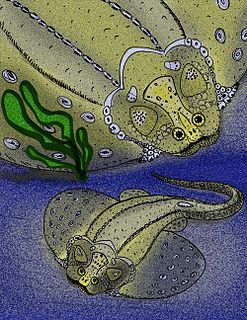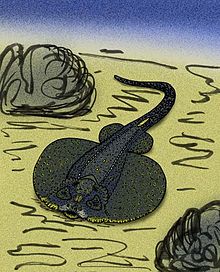
Anatomy is the branch of biology concerned with the study of the structure of organisms and their parts. Anatomy is a branch of natural science which deals with the structural organization of living things. It is an old science, having its beginnings in prehistoric times. Anatomy is inherently tied to developmental biology, embryology, comparative anatomy, evolutionary biology, and phylogeny, as these are the processes by which anatomy is generated, both over immediate and long-term timescales. Anatomy and physiology, which study the structure and function of organisms and their parts respectively, make a natural pair of related disciplines, and are often studied together. Human anatomy is one of the essential basic sciences that are applied in medicine.

Tetrapods are four-limbed animals constituting the superclass Tetrapoda. It includes extant and extinct amphibians, reptiles, and synapsids. Tetrapods evolved from a group of animals known as the Tetrapodomorpha which, in turn, evolved from ancient sarcopterygian fish around 390 million years ago in the middle Devonian period; their forms were transitional between lobe-finned fishes and the four-limbed tetrapods. The first tetrapods appeared by the late Devonian, 367.5 million years ago. The specific aquatic ancestors of the tetrapods and the process by which they colonized Earth's land after emerging from water remains unclear. The change from a body plan for breathing and navigating in water to a body plan enabling the animal to move on land is one of the most profound evolutionary changes known. The first tetrapods were primarily aquatic. Modern amphibians, which evolved from earlier groups, are generally semiaquatic; the first stage of their lives is as fish-like tadpoles, and later stages are partly terrestrial and partly aquatic. However, most tetrapod species today are amniotes, most of those are terrestrial tetrapods whose branch evolved from earlier tetrapods about 340 million years ago. The key innovation in amniotes over amphibians is the ability for the eggs to retain their aqueous contents on land, rather than needing to stay in water.

The skull is a bone structure that forms the head in vertebrates. It supports the structures of the face and provides a protective cavity for the brain. The skull is composed of two parts: the cranium and the mandible. In humans, these two parts are the neurocranium and the viscerocranium that includes the mandible as its largest bone. The skull forms the anterior-most portion of the skeleton and is a product of cephalisation—housing the brain, and several sensory structures such as the eyes, ears, nose, and mouth. In humans these sensory structures are part of the facial skeleton.

The clavicle, or collarbone, is a slender, S-shaped long bone approximately 6 inches (15 cm) long that serves as a strut between the shoulder blade and the sternum (breastbone). There are two clavicles, one on the left and one on the right. The clavicle is the only long bone in the body that lies horizontally. Together with the shoulder blade, it makes up the shoulder girdle. It is a touchable bone, and in people who have less fat in this region, the location of the bone is clearly visible, as it creates a bulge in the skin. It receives its name from the Latin clavicula, because the bone rotates along its axis like a key when the shoulder is abducted. The clavicle is the most commonly fractured bone. It can easily be fractured by impacts to the shoulder from the force of falling on outstretched arms or by a direct hit.

Fish anatomy is the study of the form or morphology of fish. It can be contrasted with fish physiology, which is the study of how the component parts of fish function together in the living fish. In practice, fish anatomy and fish physiology complement each other, the former dealing with the structure of a fish, its organs or component parts and how they are put together, such as might be observed on the dissecting table or under the microscope, and the latter dealing with how those components function together in living fish.

Placodermi is a class of armoured prehistoric fish, known from fossils, which lived from the Silurian to the end of the Devonian period. Their head and thorax were covered by articulated armoured plates and the rest of the body was scaled or naked, depending on the species. Placoderms were among the first jawed fish; their jaws likely evolved from the first of their gill arches. Placoderms are thought to be paraphyletic, consisting of several distinct outgroups or sister taxa to all living jawed vertebrates, which originated among their ranks. This is illustrated by a 419-million-year-old fossil, Entelognathus, from China, which is the only known placoderm with a type of bony jaw like that found in modern bony fishes. This includes a dentary bone, which is found in humans and other tetrapods. The jaws in other placoderms were simplified and consisted of a single bone. Placoderms were also the first fish to develop pelvic fins, the precursor to hindlimbs in tetrapods, as well as true teeth. Paraphyletic groupings are problematic, as one can not talk precisely about their phylogenic relationships, characteristic traits, and complete extinction. 380-million-year-old fossils of three other genera, Incisoscutum, Materpiscis and Austroptyctodus, represent the oldest known examples of live birth. In contrast, one 2016 analysis concluded that placodermi are likely monophyletic, though these analyses have been further dismissed with more transitional taxa between placoderms and modern gnathosthomes solidying their paraphyletic status.

A head is the part of an organism which usually includes the ears, brain, forehead, cheeks, chin, eyes, nose, and mouth, each of which aid in various sensory functions such as sight, hearing, smell, and taste, respectively. Some very simple animals may not have a head, but many bilaterally symmetric forms do, regardless of size.

Deinosuchus is an extinct genus of alligatoroid crocodilian related to the modern alligator that lived 82 to 73 million years ago (Ma), during the late Cretaceous period. The name translates as "terrible crocodile" and is derived from the Greek deinos (δεινός), "terrible", and soukhos (σοῦχος), "crocodile". The first remains were discovered in North Carolina in the 1850s; the genus was named and described in 1909. Additional fragments were discovered in the 1940s and were later incorporated into an influential, though inaccurate, skull reconstruction at the American Museum of Natural History. Knowledge of Deinosuchus remains incomplete, but better cranial material found in recent years has expanded scientific understanding of this massive predator.

The mountain beaver is a North American rodent. It is the only living member of its genus, Aplodontia, and family, Aplodontiidae. It should not be confused with true North American and Eurasian beavers, to which it is not closely related, being more closely related to squirrels.
Peloneustes is a genus of pliosaurid plesiosaur from the Middle Jurassic of England. Its remains are known from the Peterborough Member of the Oxford Clay Formation, which is Callovian in age. It was originally described as a species of Plesiosaurus by palaeontologist Harry Govier Seeley in 1896, before being given its own genus by naturalist Richard Lydekker in 1889. While many species have been assigned to Peloneustes, P. philarchus is currently the only one still considered valid, with the others moved to different genera, considered nomina dubia, or synonymised with P. philarchus. Some of the material formerly assigned to P. evansi have since been reassigned to "Pliosaurus" andrewsi. Peloneustes is known from many specimens, including some very complete material.

Petalichthyida is an extinct order of small, flattened placoderm fish. They are typified by their splayed pectoral fins, exaggerated lateral spines, flattened bodies, and numerous tubercles that decorated all of the plates and scales of their armor. They reached a peak in diversity during the Early Devonian and were found throughout the world, particularly in Europe, North America, Asia, South America, and Australia. The petalichthids Lunaspis and Wijdeaspis are among the best known. The earliest and most primitive known petalichthyid is Diandongpetalichthys, which is from earliest Devonian-aged strata of Yunnan. The presence of Diandongpetalichthys, along with other primitive petalichthyids including Neopetalichthys and Quasipetalichthys, and more advanced petalichthyids, suggest that the order may have arisen in China, possibly during the late Silurian.

Rhenanida is an order of scaly placoderms. Unlike most other placoderms, the rhenanids' armor was made up of a mosaic of unfused scales and tubercles. The patterns and components of this "mosaic" correspond to the plates of armor in other, more advanced placoderms, suggesting that the ancestral placoderm had armor made of unfused components, as well.

Gemuendina stuertzi is a placoderm of the order Rhenanida, of the seas of Early Devonian Germany. In life, Gemuendina resembled a scaly ray with an upturned head, or a large-finned stargazer. G. stuertzi is often invoked as an example of convergent evolution- with its flat body and huge, wing-like pectoral fins it has a strong, albeit superficial similarity to rays. Unlike rays, however, both Gemuendina`s eyes and nostrils were placed atop the head, facing upward. Furthermore, G. stuertzi's upturned mouth would have enabled it to suction prey that swam overhead, rather than swallow sediment or suction prey out of the substrate like modern rays.

Phyllolepida is an extinct taxon of flattened placoderms found throughout the world, with fossils being found in Devonian strata. Like other flattened placoderms, the phyllolepids were bottom-dwelling predators that ambushed prey. Unlike other flattened placoderms, the phyllolepids were inhabitants of freshwater environments.

Acanthothoraci is an extinct group of chimaera-like placoderms who were closely related to the rhenanid placoderms. Superficially, the acanthoracids resembled scaly chimaeras, or (relatively) heavily armored ptyctodonts. They were distinguished from chimaeras by the presence of large scales and plates, a pair of large spines that emanate from their chests, tooth-like beak plates, and the typical bone-enhanced placoderm eyeball. They were distinguished from other placoderms due to differences in the anatomy of their skulls, and due to patterns on the skull plates and thoracic plates that are unique to this order.

Gogonasus was a lobe-finned fish known from three-dimensionally preserved 380-million-year-old fossils found from the Gogo Formation in Western Australia. It lived in the Late Devonian period, on what was once a 1,400-kilometre coral reef off the Kimberley coast surrounding the north-west of Australia. Gogonasus was a small fish reaching 30–40 cm (1 ft) in length.

Weejasperaspididae is a family of three extinct acanthothoracid placoderms indigenous to the Early Devonian of Victoria and New South Wales, Australia.

Marine vertebrates are vertebrates that live in marine environments. These are the marine fish and the marine tetrapods. Vertebrates are a subphylum of chordates that have a vertebral column (backbone). The vertebral column provides the central support structure for an internal skeleton. The internal skeleton gives shape, support, and protection to the body and can provide a means of anchoring fins or limbs to the body. The vertebral column also serves to house and protect the spinal cord that lies within the column.

The skull roof, or the roofing bones of the skull, are a set of bones covering the brain, eyes and nostrils in bony fishes and all land-living vertebrates. The bones are derived from dermal bone and are part of the dermatocranium.

Most bony fishes have two sets of jaws made mainly of bone. The primary oral jaws open and close the mouth, and a second set of pharyngeal jaws are positioned at the back of the throat. The oral jaws are used to capture and manipulate prey by biting and crushing. The pharyngeal jaws, so-called because they are positioned within the pharynx, are used to further process the food and move it from the mouth to the stomach.



















